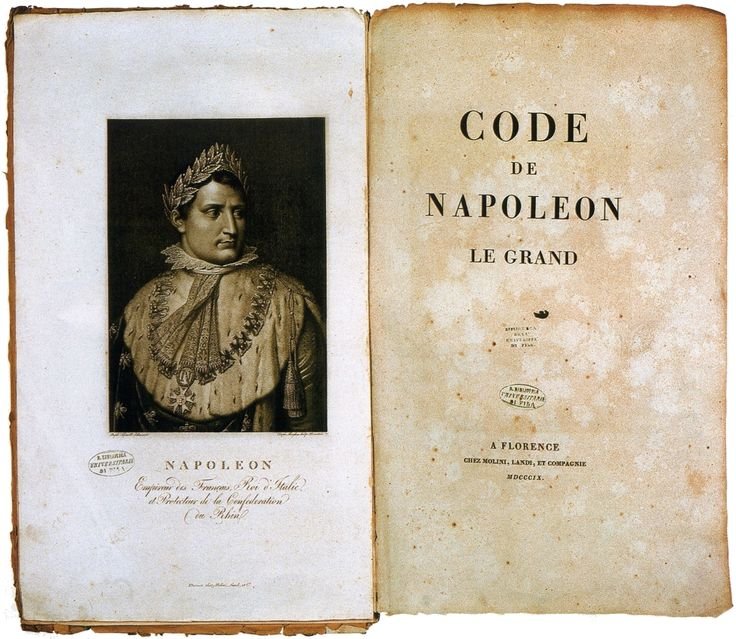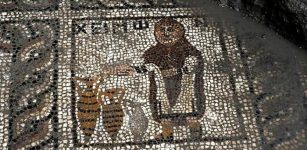Napoleonic Code: Why Was One Of The Most Influential Civil Codes Flawed?
A. Sutherland - AncientPages.com - Napoleonic Code was the French Civil Code introduced under Napoleon I on 21 March 1804.
It was the first consistent set of laws concerning criminal and commercial law, property, the family, colonial affairs, and individual rights, given by Napoleon to his people living in post-revolutionary France. The Code eliminated feudalism, supported religious tolerance, and introduced other liberal European reforms.
It is a set of organized laws, considered one of Napoleon's most essential and lasting legacies. The French military commander and political leader Napoleon Bonaparte (1769–1821) was inspired by Roman law and principles of the French Revolution to create this progressive legal system,
It has been generally considered a progressive legal system reflecting broad-minded values. The Code required that for laws to be applied appropriately, secret laws were ended. Ex post facto laws were invalidated, and procedures were needed to make the application of the rules fair.
Unfortunately, colonial slavery was reintroduced. The Code was modified and widely adopted outside France in Europe and the Western Hemisphere.
However, the Napoleonic Code made the authority of men over their families stronger, deprived women of any individual rights, and reduced the rights of illegitimate children.
The Code may not have been favorable for women, historians say.
Napoleonic Code And Women
The Code made women legally and economically dependent on men. Women acquired their husbands' nationality upon marriage and had to reside where their husbands desired. The Code guaranteed the supremacy of the man over his wife and children; the husband was the ruler of the household.

Code de Napoleon Le Grand/ The Napoleonic Code. Source
In "Changing Lives: Women in European History Since 1700", Bonnie G. Smith writes:
"Women could not participate in lawsuits or serve as witnesses in court or as witnesses to civil acts such as births, deaths, and marriages. Such a reduction in a woman's civil status enhanced that of the individual male.
Moreover, the Code reduced, if not eliminated, male accountability for sexual acts and thrust it squarely on women. For example, men were no longer susceptible to paternity suits or legally responsible for the support of illegitimate children.
Economically, women were weakened if they bore illegitimate children. Men, on the other hand, were not so affected if they fathered them. Finally, female adultery was punished by imprisonment and fines unless the husband relented and took his wife back.
Men, however, suffered no such sanctions unless they brought their sexual partners into the home. The sexual behavior of women was open to scrutiny and prescribed by law, whereas that of men, almost without exception, had no criminal aspect attached to it.
Thus, "male sexuality was accepted with few limitations, but women's was only acceptable if it remained within strict domestic boundaries." (Bonnie G. Smith, Changing Lives: Women in European History Since 1700)
The abolition of divorce by mutual consent amounted to a significant regression for French women.
- A woman cannot contract a new marriage until ten months have elapsed from the dissolution of the preceding marriage.
- The wife may demand a divorce on the ground of adultery in her husband when he shall have brought his concubine into their shared residence.
- The married parties may reciprocally demand divorce for outrageous conduct, ill-usage, or grievous injuries, exercised by one of them towards the other. 1
As the Napoleonic Code strongly influenced many legal systems in Europe and the New World, it also set the terms for treating women widely. Napoleon was pleased that his new laws had been spread throughout the empire, and said late in his life:
'Waterloo will wipe out the memory of my forty victories, but that which nothing can wipe out is my Civil Code. That will live forever.'
An original copy of the Napoleonic Code is stored in the Historisches Museum der Pfalz in Speyer, Germany.
Written by – A. Sutherland - AncientPages.com Senior Staff Writer
Updated on January 1, 2024
Copyright © AncientPages.com All rights reserved. This material may not be published, broadcast, rewritten or redistributed in whole or part without the express written permission of AncientPages.com
Expand for referencesReferences:
Smith B. G. The Oxford Encyclopedia of Women in World History
- Philip G. Dwyer, Napoleon and Europe
More From Ancient Pages
-
 Amazing New Frescoes With Mythological Individuals Discovered At Pompeii
Archaeology | Apr 11, 2024
Amazing New Frescoes With Mythological Individuals Discovered At Pompeii
Archaeology | Apr 11, 2024 -
 New Path For Early Human Migrations Contradicts A Single ‘Out Of Africa’ Theory
Evolution | Oct 5, 2023
New Path For Early Human Migrations Contradicts A Single ‘Out Of Africa’ Theory
Evolution | Oct 5, 2023 -
 Ancient Manuscript In Museum Reveals Discovery Of Objects Unknown To Modern Science – Coptic Secrets And Guardians Of Treasures – Part 2
Ancient Mysteries | Apr 11, 2021
Ancient Manuscript In Museum Reveals Discovery Of Objects Unknown To Modern Science – Coptic Secrets And Guardians Of Treasures – Part 2
Ancient Mysteries | Apr 11, 2021 -
 Evidence Of Stone Age Ear and Lip Piercing Found At Boncuklu Tarla Neolithic Site In Türkiye
Archaeology | Mar 14, 2024
Evidence Of Stone Age Ear and Lip Piercing Found At Boncuklu Tarla Neolithic Site In Türkiye
Archaeology | Mar 14, 2024 -
 Kentucky’s Little-Known Ancient Underground City And Mysterious Lost Civilization
Featured Stories | Jun 13, 2024
Kentucky’s Little-Known Ancient Underground City And Mysterious Lost Civilization
Featured Stories | Jun 13, 2024 -
 Cats In The Middle Ages: What Medieval Manuscripts Teach Us About Our Ancestors’ Pets
Featured Stories | Dec 24, 2022
Cats In The Middle Ages: What Medieval Manuscripts Teach Us About Our Ancestors’ Pets
Featured Stories | Dec 24, 2022 -
 Evidence Of At Least Two Lineages Of Late Neanderthals In Europe Discovered
Human Beginnings | Oct 21, 2024
Evidence Of At Least Two Lineages Of Late Neanderthals In Europe Discovered
Human Beginnings | Oct 21, 2024 -
 Old Kingdom Mastaba Decorated With Rare Paintings Found In Dahshur Necropolis, Egypt
Archaeology | Mar 22, 2024
Old Kingdom Mastaba Decorated With Rare Paintings Found In Dahshur Necropolis, Egypt
Archaeology | Mar 22, 2024 -
 On This Day In History: ‘Edict Of Nantes’ About Freedom Of Religion Issued By Henry IV – On Apr 13, 1598
News | Apr 13, 2017
On This Day In History: ‘Edict Of Nantes’ About Freedom Of Religion Issued By Henry IV – On Apr 13, 1598
News | Apr 13, 2017 -
 Piecing Together Scotland’s Religious Past With Shards Of Glass
Archaeology | Feb 28, 2023
Piecing Together Scotland’s Religious Past With Shards Of Glass
Archaeology | Feb 28, 2023 -
 Cave Hidden Under Pembroke Castle in Wales Could Hold Secrets Dating Back 10,000 Years
Archaeology | Jul 16, 2022
Cave Hidden Under Pembroke Castle in Wales Could Hold Secrets Dating Back 10,000 Years
Archaeology | Jul 16, 2022 -
 Norse Shamanism: A Völva And Her Prophecies Were Feared Among Norse Gods And Vikings
Featured Stories | May 19, 2020
Norse Shamanism: A Völva And Her Prophecies Were Feared Among Norse Gods And Vikings
Featured Stories | May 19, 2020 -
 Oldest Known Fossil Footprints Discovered On Crete By Polish Researcher Challenge Established Theories Of Human Evolution
Archaeology | Nov 11, 2017
Oldest Known Fossil Footprints Discovered On Crete By Polish Researcher Challenge Established Theories Of Human Evolution
Archaeology | Nov 11, 2017 -
 Illapa: Powerful Master Of Clouds, Rain And Hail – Worshipped By Inca People
Featured Stories | Jul 7, 2016
Illapa: Powerful Master Of Clouds, Rain And Hail – Worshipped By Inca People
Featured Stories | Jul 7, 2016 -
 Astronomically Aligned Temples And Pyramids Of Ancient World
Featured Stories | Dec 10, 2021
Astronomically Aligned Temples And Pyramids Of Ancient World
Featured Stories | Dec 10, 2021 -
 These Curious Burials Could Challenge Historians’ Ideas About Anglo-Saxon Gender
Featured Stories | Oct 3, 2023
These Curious Burials Could Challenge Historians’ Ideas About Anglo-Saxon Gender
Featured Stories | Oct 3, 2023 -
 Ancient Mosaics Dated To The First Century Discovered In Southern Turkey
Archaeology | Jan 14, 2019
Ancient Mosaics Dated To The First Century Discovered In Southern Turkey
Archaeology | Jan 14, 2019 -
 Fascinating Portable Art From Torre Cave, Gipuzkoa – One Of The Most Complete Specimens From The Entire Iberian Peninsula
Archaeology | May 26, 2023
Fascinating Portable Art From Torre Cave, Gipuzkoa – One Of The Most Complete Specimens From The Entire Iberian Peninsula
Archaeology | May 26, 2023 -
 Hunter-Gatherers Of Baltic Region Had Culturally Distinct Cuisines Related To Traditions
Archaeology | Apr 23, 2020
Hunter-Gatherers Of Baltic Region Had Culturally Distinct Cuisines Related To Traditions
Archaeology | Apr 23, 2020 -
 Mystery Of The Ancient Unknown Mining Civilization In North America – Connecting the Dots – Part 2
Ancient Mysteries | Apr 23, 2022
Mystery Of The Ancient Unknown Mining Civilization In North America – Connecting the Dots – Part 2
Ancient Mysteries | Apr 23, 2022

